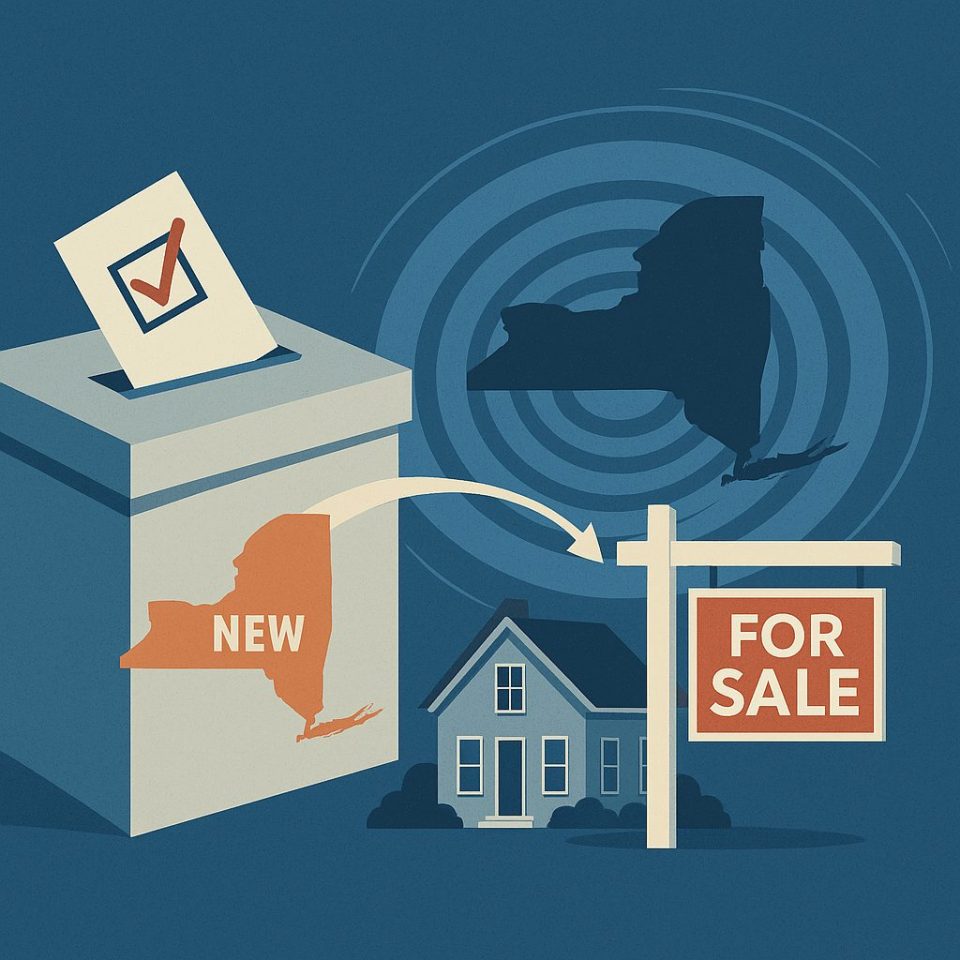For years, New York has been a symbol of opportunity, a place where ambition, diversity, and energy collide. But behind the skyline, a quiet movement has been building. More New Yorkers are selling, packing up, and moving to new states than ever before.
The exodus isn’t just about taxes or housing costs anymore. It’s becoming political. Following the 2025 New York City mayoral election, where progressive candidate Zohran Mamdani secured victory on a platform promising rent freezes, expanded tenant protections, and higher taxes for the wealthy, the conversation around leaving New York has gained a new urgency.
For real estate agents, this political shift could mean an influx of listings, a surge in relocation business, and a chance to position themselves at the center of one of the most significant housing migrations of the decade.
The Political Spark Behind the Migration
New York’s challenges aren’t new. High property taxes, steep rents, aging infrastructure, and a high cost of living have been weighing on residents for years. But political change is now adding emotional fuel to a slow-burning fire.
Mamdani’s win represented a major shift in direction for the city. His policies are designed to make New York more affordable for renters and working-class residents, but they’re also causing concern among property owners, investors, and businesses who fear stricter rent regulations, new tax brackets, and increased oversight on development projects.
According to early polling after the election, roughly one in four New Yorkers said they’re now “seriously considering” relocating within the next year. That sentiment is strongest among high-income earners, landlords, and small business owners, the very people who drive much of the city’s housing and commercial investment. What’s happening isn’t just about affordability anymore. It’s about confidence. When residents and investors begin to feel uncertain about the direction of policy, they start looking for stability elsewhere. And that’s exactly what we’re seeing.
Where New Yorkers Are Going

Every migration pattern tells a story, and New York’s is increasingly predictable. Outbound moves are following a few key routes:
Florida: The Sunshine Destination
Florida remains the number-one landing spot for former New Yorkers. It offers no state income tax, lower property costs, and a lifestyle that appeals to retirees and remote professionals alike. Cities like Tampa, Orlando, and Palm Beach continue to see a steady flow of buyers cashing out of their New York equity.
The Carolinas: Balanced Growth and Affordability
North Carolina and South Carolina are quietly becoming favorites for middle-income families leaving the Northeast. Charlotte, Raleigh, and Greenville provide strong job markets, affordable housing, and growing cultural scenes that feel like a less-crowded version of New York’s suburbs.
Pennsylvania: Close to NYC, But Different
Not everyone wants to move thousands of miles away. Pennsylvania, particularly the Poconos, Lehigh Valley, and suburban Philadelphia, attracts former New Yorkers who want lower costs without fully cutting ties to the Northeast. These “half-back” moves allow sellers to downsize costs while staying within weekend distance of Manhattan.
Texas and Tennessee: Business-Friendly Booms
As corporate relocations increase, so does individual migration. Both states offer low taxes, high growth, and large new-construction inventory. Austin, Dallas, and Nashville are major magnets for New Yorkers looking to maintain urban amenities without urban prices.
How Politics Is Shaping the Real Estate Market

The election didn’t cause New York’s population decline, it accelerated it. Before the 2025 results, New York’s population had already fallen by roughly half a million since 2020. Now, political uncertainty is turning a steady drip into a faster flow. Real estate professionals across the state are noticing three emerging trends:
1. Increased Listing Activity
More homeowners are listing properties earlier than planned, hoping to sell before potential tax adjustments or new rent regulations take effect. This creates an opportunity for listing agents, particularly those skilled at marketing to out-of-state buyers.
2. Cooling Luxury Demand
High-end buyers, both domestic and international, are taking a wait-and-see approach. Luxury condo absorption rates in Manhattan and Brooklyn are slowing, while suburban and secondary markets show more consistent demand.
3. Growing Suburban Demand
Counties like Rockland, Orange, and Dutchess are seeing renewed interest from residents seeking more space and a sense of security while staying close to New York City. For agents, this means repositioning marketing efforts toward lifestyle appeal and family-friendly amenities.
The Ripple Effect Beyond New York
Every homeowner who sells in New York becomes a buyer somewhere else. That’s where opportunity expands beyond state borders. When a family sells their condo in Queens and buys in Tampa, that’s two sides of the same migration, and two agents’ commissions. Multiply that by tens of thousands of moves per year, and it’s easy to see why relocation-based business is booming.
This shift is also giving rise to multi-state MLS systems like MyState MLS, which allow agents to list properties across the country without joining multiple regional boards. Agents who operate on both ends of the migration, selling real estate in New York and referring in Florida, for instance, can turn the state’s population loss into a national growth strategy.
How Agents Can Capitalize on the Political Migration

1. Understand the Sentiment Behind the Move
When politics drives a relocation decision, it’s often emotional. Clients may be frustrated, anxious, or uncertain about their future. Listen first, then offer solutions that turn frustration into action. Market yourself as the agent who helps clients “move forward with purpose.”
2. Create Targeted Relocation Guides
Build content around trending searches like “leaving New York after the election,” “best states for tax relief,” or “where to move from New York in 2025.” These resources attract sellers and out-of-state buyers searching for guidance.
3. Partner With Agents in Destination States
Form referral alliances in key markets like Florida, North Carolina, and Texas. Cross-market listings and share leads. If you use MyState MLS, your listings are already syndicated nationwide, meaning potential buyers relocating to or from New York can find your properties anywhere.
4. Use Political Awareness in Your Marketing (Tactfully)
You don’t have to take sides. Instead, speak to the practical outcomes of policy change. For example: “Thinking about selling before new rent laws take effect? Let’s discuss your options.” Staying neutral while acknowledging the environment builds trust.
5. Focus on Investors and Developers
Periods of political uncertainty often create opportunities for investors seeking value. As some owners exit the market, others see an opening. Representing small-scale investors or developers looking for undervalued properties can be a profitable niche in shifting times.
The Opportunity Hidden in the Headlines
While many see New York’s population decline as a warning sign, savvy agents recognize it as a cycle, one that brings new chances for growth.
- Listing inventory is increasing.
- Out-of-state buyer demand is growing.
- Multi-state networking tools are stronger than ever.
For every seller leaving New York, there’s a buyer entering another market. The question isn’t whether agents can survive this shift, it’s whether they’re positioned to benefit from both sides of it.
Looking Ahead
The 2025 election results underscored something bigger than a mayoral race: they revealed just how interconnected politics, economics, and real estate truly are.
The decisions made in City Hall ripple far beyond Manhattan’s borders, they influence where people live, how they invest, and when they move. As residents vote with their feet, agents who understand those motivations will stay one step ahead.
New York’s story isn’t ending. It’s evolving, and so is the business of real estate. For agents, the next chapter is about mobility, adaptability, and national reach. Whether your clients are staying, selling, or heading south, there’s an opportunity at every step.
